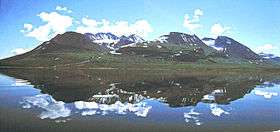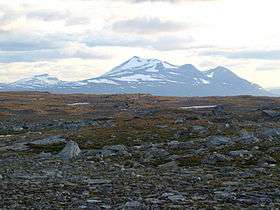Áhkká
| Áhkká | |
|---|---|
 Áhkká seen from lake Áhkájávrre, July 2000 | |
| Highest point | |
| Elevation | 2,015 m (6,611 ft) |
| Prominence | 1,105 m (3,625 ft) |
| Coordinates | 67°35′N 17°29′E / 67.583°N 17.483°ECoordinates: 67°35′N 17°29′E / 67.583°N 17.483°E |
| Naming | |
| Translation | Old woman (Lule Sami) |
| Geography | |
 Áhkká | |
| Parent range | Scandinavian Mountains |
Áhkká (Lule Sami: "old woman"), also known in its "Swedified" form Akka, is a massif in the southwestern corner of Stora Sjöfallet National Park in northern Sweden.
The massif has twelve individual peaks and ten glaciers,[1] of which Stortoppen is the highest at 2,015 m (6,611 ft). This peak is the eighth highest in Sweden. Most notable is that the mountain has a vertical drop of 1,563 metres (5,128 ft), from the top of the highest summit down to the lake Akkajaure in the valley below, which is located at 453 m (1,486 ft). This is the highest vertical drop found in Sweden. Since the lake below the mountain is regulated by a hydroelectric power station, its surface can drop down to 423 m (1,388 ft) which makes the mountains vertical drop rise to a maximum of 1,593 m (5,226 ft). Due to the large level differences and the fact that the massif is well held together and rather isolated, it has an impressive appearance, earning it the nickname Queen of Lapland. In the Sámi tradition it is a holy mountain, and some hikers regard it with a sense of awe and mystique.
 Summit of Áhkká from the north-eastern peak
Summit of Áhkká from the north-eastern peak Áhkká massif in July 2009 seen from the north-east.
Áhkká massif in July 2009 seen from the north-east.
References
- ↑ Juho Risku (May 2012). "Preparing for Mt. Logan at Akka". climbingextreme.com. Retrieved 2012-05-06.